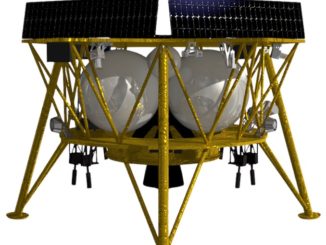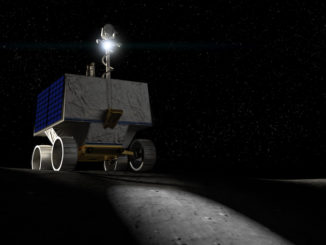
With the company’s future riding on it, United Launch Alliance’s first Vulcan rocket successfully put a commercial robotic lander on course for the Moon after lifting off from Cape Canaveral’s pad 41 at 2:18 a.m. EST (0718 UTC).
This mission was the first certification flight of Vulcan, an important proving ground for the first launch vehicle developed by ULA since it was established in 2006. The milestone comes roughly a decade after the rocket was first announced.
“Yeehaw! I’m so thrilled! I can’t tell you how much,” said ULA President and CEO Tory Bruno after the rocket’s upper stage sent the Astrobotic Peregrine lunar lander on its way.
This first certification mission for Vulcan (Cert-1) was also an historic step in returning the U.S. back to the Moon’s surface for the first time since 1972. The primary payload onboard the rocket was a privately-funded robotic lunar lander, which was built by Pittsburgh-based company, Astrobotic.
A few minutes after the Peregrine lander separated from the Centaur 5 upper stage, flight teams with Astrobotic confirmed that they were getting telemetry data from the lander.
“Today Peregrine Mission One achieved a number of big milestones,” said John Thornton, CEO of Astrobotic, in a statement. “Peregrine powered on, acquired a signal with Earth, and is now moving through space on its way to the Moon. These successes bring us one step closer to seven nations landing on the Moon, six of which have never been to the Moon before.”
Following a successful separation from the launch vehicle, Astrobotic Mission Control has established communications with Peregrine Mission One #PM1 and confirmed it is functioning nominally. All Phase 2 objectives are now complete. Next stop, lunar orbit! pic.twitter.com/SjGo4pXdPQ
— Astrobotic (@astrobotic) January 8, 2024
The lander carries onboard 20 payload, five of which were from NASA as part of its Commercial Lunar Payload Services (CLPS) program. It’s a novel way for the agency to send science instruments and other cargo to the lunar surface without having to have a dedicated mission.
“The first CLPS launch has sent payloads on their way to the Moon – a giant leap for humanity as we prepare to return to the lunar surface for the first time in over half a century,” said NASA Administrator Bill Nelson in a statement. “These high-risk missions will not only conduct new science at the Moon, but they are supporting a growing commercial space economy while showing the strength of American technology and innovation. We have so much science to learn through CLPS missions that will help us better understand the evolution of our solar system and shape the future of human exploration for the Artemis Generation.”
The Peregrine lander is now set to make its landing attempt on February 23.
ULA appeared to have a seemingly flawless countdown over the course of roughly 10 hours with no, unplanned holds or delays that cropped up. Vulcan marked its place in history as the first U.S. rocket powered by a combination of methane and liquid oxygen to successfully reach orbital velocity and deploy its payload as planned.
“I’m so proud of this team. This has been years of hard work. So far, this has been an absolutely beautiful mission back to the Moon and off to our next burn where we will do our final payload deployment to that heliocentric orbit for the memorial,” Bruno said.
About 25 minutes after those comments, the Centaur 5 upper-stage completed its third and final burn to send the “Enterprise Flight” on its way to orbit the Sun on behalf of Celestis Memorial Flights. On board are the ashes of several people, including “Star Trek” creator Gene Rodenberry.
“The successful development and flight of this evolutionary rocket is a true testament to the unrivaled dedication and ingenuity of our workforce,” said Mark Peller, vice president of Vulcan Development in a statement. “Vulcan’s purpose-built design leverages the best of what we’ve learned from more than 120 combined years of launch experience with Atlas and Delta, ultimately advancing our nation’s space capability and providing unprecedented mission flexibility.”
A new chapter for ULA and Blue Origin
With the launch of the first Vulcan rocket now in the books, ULA is one step closer to a couple of key transition points. First, the launch vehicle is now essentially 50 percent of the way to being able to support national security missions.
A requirement for gaining clearance to launch National Security Space Launch (NSSL) contracted missions is that Vulcan needs to fly two consecutive, successful certification missions. Ahead of Monday’s Cert-1 launch, Gary Wentz, the vice president of Government and Commercial Programs, said ULA intended to set aside 60 days following the launch in order to “review the data, review any observations we have and if everything’s nominal, we would be prepped and ready to proceed.”
The second and final certification mission is planned to be the launch of the Sierra Space Dream Chaser spaceplane. This first Dream Chaser, dubbed “Tenacity,” is currently undergoing testing and simulations at NASA’s Neil Armstrong Test Facility in Ohio.
Wentz said they could potentially be ready to launch this next mission as early as April from a Vulcan perspective.
Following vibration testing, Dream Chaser will be moved to the propulsion facility for thermal vacuum testing to simulates the environment the spacecraft will encounter during its mission to the @Space_Station.
NASA Blog: https://t.co/WX1FHKaZe1 pic.twitter.com/meUMuFJsN7
— Sierra Space (@SierraSpaceCo) December 15, 2023
The mission also marked a key milestone for Blue Origin. The company is in the process of bringing its own heavy lift capabilities online with its New Glenn rocket. The launch of Vulcan was a marquee risk reduction for them since they have now been able to witness and will study the first flight of their BE-4 engines in space.
A pair of these methane and liquid oxygen-fueled engines helped power the Vulcan booster stage during the first several minutes of the launch.
Congratulations @ULALaunch! Team Blue celebrates Vulcan’s first launch! #PoweredByBE4 https://t.co/cFOgBoRxis
— Blue Origin (@blueorigin) January 8, 2024
If all goes well with the planning and execution of the Cert-2 mission, ULA is poised to launch another pair of BE-4 engines before the first launch of New Glenn later this year.
“The two engines for Cert-2 are complete. They’re assembled and they’re actually down at their West Texas facility going through final acceptance hot fire,” Peller said on Friday. “So, they’re on track.”
Peller added that both the Vulcan booster and the Centaur 5 upper stage “are also in final assembly at our Decatur facility.”




The BE-4 engine is slated to replace the Russian RD-180, right?
If so, that’s the real story here—getting us weaned off that ill-founded Russian dependence.
These missions are all a step forward in space Xploration and going back to the Moon. I am very Xcited to see what man can achieve in space.
Did they recover the first stage engines? I understood that that was the plan for Vulcan.
Unbelievable! I guess slow and steady will always beat quick and fast. Congrats to Boeing and all it’s team members. Thanks
I was nervous about Peregrine and Dream Chaser launching on certification flights. It might still be good for Dream Chaser to have the ability to separate from Centaur and its fairings and glide to a landing in the event of an early cutoff of thrust of Vulcan or Centaur, if it doesn’t have this capability already, even without a launch escape system, as it’s been seen before where an anomaly can destroy a rocket yet leave the payload intact
It might make economic and practical sense to equip unmanned payloads with a launch escape system, such as the unmanned New Shephard flight possessed during the anomaly in 2022, saving the capsule and the payloads inside.
PS – Regarding the question about engine recovery, I understand that ULA does intend to eventually develop the ability to recover the BE-4 engines after each Vulcan launch. Perhaps they will consider recovering the entire first stage.
SMART reuse won’t begin for Vulcan for a while yet, so the engines were not recovered on this flight. This is unfortunate, because FE-1 and 2 showed between their acceptance hotfire tests and their FRF tests that they were very solid engines and would’ve been flight-proven.
Laurence, it would take many years and near-complete redesign of the Vulcan booster to allow recover of the whole stage. The BE-4 does have a very deep throttle capability for an engine of this size, but not enough to allow vertical landing ala what Blue does with New Shepard (hopefull soon also New Glenn!), and SpaceX does with Falcon 9.
Building a new launch vehicle without a fully re-usable first stage after SpaceX has been doing that for years is like building another piston airliner years after jet airliners came out. Meanwhile SpaceX is already working on a re-usable second stage.
@nicksj ula started design for vulcan 3 years before the first sX landing
the concept of falcon heavy and re-use of qty3 falcon9 1st stage boosters for vulcan/glenn/bfr throw weight was fiction years in to vulcan development
@tomfreiling in the history of US spaceflight this is a top-10 technology event, akin to the eventual development of aerospike and “atomic” propulsion
CONGRATULATIONS TEAM BEZOS
GAME ON